Layout and features
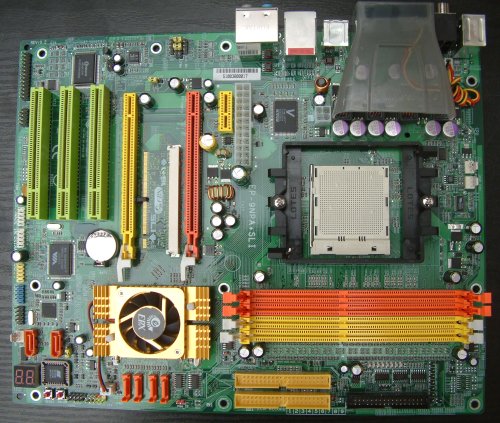
The EPoX EP-9NPA+ SLI's layout is anything but conventional; 2 full-length PCI-Express slots take care of that.
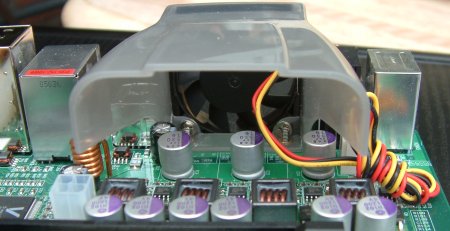
Here's how EPoX intends to keep the hot-running components near the CPU socket cool. A 40mm fan exhausts warm air from around the power-delivery area. The overall effect is enhanced by having a shroud surrounding it. Gimmick or genuinely useful feature? Running the board at default speeds and with an AMD Athlon 64 FX-53 CPU, a Prime95 torture test load temperature of 68c was reached after 15 minutes. Switching off the fan by pulling out the header increased the CPU's load temperature, according to EPoX's USDM utility, to 74c. There's a steady stream of warm air that's moved on over the capacitors and out of the back of the case.
The fan's not particularly annoying, which is good news, as 40mm fans tend to be high pitched. There was no problem in installing an AMD Athlon PIB cooler. What's kind of annoying, however, is just where EPoX have located the 4-pin 12v power connector; right next to the shroud. The main 20-pin connector isn't in an ideal location either, and you have to pull the PSU's wires across the motherboard, interrupting airflow.
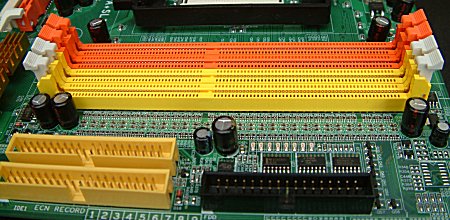
It's dual-channel DDR1 for S939. Run 2 DIMMs in either yellow or orange slots, or populate all. Kind of hard to see on the above picture but just above the floppy drive port, EPoX has added a number of LEDs that are analagous to Corsair's XPert RAM's. They light up when there's RAM activity. EPoX calls this gizmo LEDION. There's also no problem in installing and removing system RAM without having to remove the right-hand graphics card, which is good thinking on EPoX's part.
It seems as if EPoX and ABIT board designers are out to outshine one another, both in terms of performance and onboard LEDs. The 9NPA+ SLI has four blue LEDs that look kind of funky. Of course, you'll need a windowed case and dark room to appreciate this aesthetic.
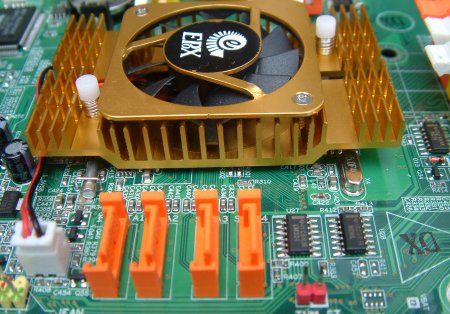
NVIDIA has just a single chip for its nForce4 SLI core logic. That frees up a chunk of PCB real estate that can be used for additional features, but it also makes the single-chip design rather warm. EPoX has sensibly added an aluminium heatsink/fan combination. The heatsink gets pretty warm to the touch, too. In the foreground, kind of blurred, is the header for EPoX's Thermo Stick. Note that the 4 SATA ports, running of the nForce4 SLI, all support the SATA2 protocol, which offers NCQ and faster transfer speeds. RAID0, 1, 0+1, and JBOD modes are supported.

Moving on to the left, EPoX bundles in a couple of decent features. The first, an invaluable aid to testers, are onboard power and reset buttons. The second is a debug LED display that cycles through a range of codes during the POST sequence. If the board fails to POST correctly, the debug LED stops at a certain number/code which can then be cross-referenced against the manual. Colour-coded case pins are also a nice touch. Just behind are two SATA ports that are run off the tiny Silicon Image PCI-Express-based Sil3132 ASIC. It also offers SATA2 compliance, as well as RAID0 and RAID1 formats.
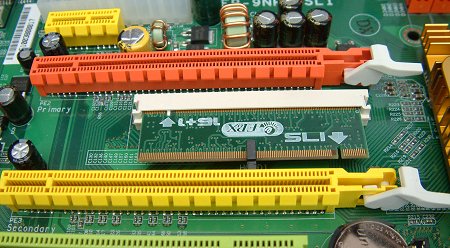
The above shot shows the board set to run discrete graphics via a single x16 PCI-Express slot. Turn the switching key around and you can have SLI'd fun. Not as elegant as MSI's intelligent digital switching, though. There's 3 regular PCI slots (32-bit, 33MHz) and only a single x1 PCI-Express slot, which is stuck between the 20-pin power block and right-hand x16 slot; not the most elegant layout.
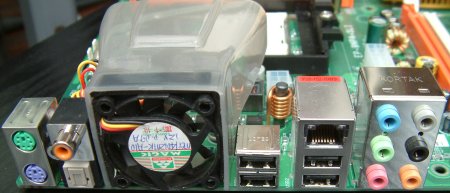
Note the large shroud/duct?. It takes up enough space to relegate legacy ports out of the I/O section. Sound, via NVIDIA's nForce4 SLI, is routed through Realtek's ALC850 8-channel CODEC and out to the back. External connection is made through the 6 sound jacks on the right-hand side. S/PDIF is available through optical-in and coaxial-out. There's 4 USB 2.0 ports on the back, which leaves a further 6 available via onboard headers (2 of which are accommodated by a supplied bracket). Gigabit LAN, again run from the chipset through a Vitesse physical layer is naturally available through an RJ45 port. FireWire400, supported on the board through VIA's VT6307 ASIC, is only available via an external bracket.
EPoX has amalgamated a decent number of features, including SLI compatibility, for a deluxe motherboard costing £105. The layout could use a re-think, especially with respect to the present location of the power connectors.









